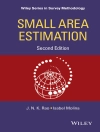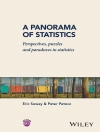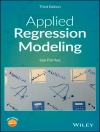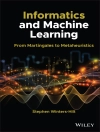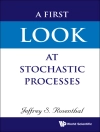A highly accessible alternative approach to basic statistics Praise
for the First Edition: 'Certainly one of the most impressive
little paperback 200-page introductory statistics books that I will
ever see . . . it would make a good nightstand book for every
statistician.’–Technometrics
Written in a highly accessible style, Introduction to Statistics
through Resampling Methods and R, Second Edition guides students in
the understanding of descriptive statistics, estimation, hypothesis
testing, and model building. The book emphasizes the discovery
method, enabling readers to ascertain solutions on their own rather
than simply copy answers or apply a formula by rote. The
Second Edition utilizes the R programming language to simplify
tedious computations, illustrate new concepts, and assist readers
in completing exercises. The text facilitates quick learning
through the use of:
More than 250 exercises–with selected 'hints’–scattered
throughout to stimulate readers’ thinking and to actively engage
them in applying their newfound skills
An increased focus on why a method is introduced
Multiple explanations of basic concepts
Real-life applications in a variety of disciplines
Dozens of thought-provoking, problem-solving questions in the final
chapter to assist readers in applying statistics to real-life
applications
Introduction to Statistics through Resampling Methods and R, Second
Edition is an excellent resource for students and practitioners in
the fields of agriculture, astrophysics, bacteriology, biology,
botany, business, climatology, clinical trials, economics,
education, epidemiology, genetics, geology, growth processes,
hospital administration, law, manufacturing, marketing, medicine,
mycology, physics, political science, psychology, social welfare,
sports, and toxicology who want to master and learn to apply
statistical methods.
Spis treści
Preface xi
1. Variation 1
1.1 Variation 1
1.2 Collecting Data 2
1.3 Summarizing Your Data 4
1.4 Reporting Your Results 7
1.5 Types of Data 11
1.6 Displaying Multiple Variables 12
1.7 Measures of Location 15
1.8 Samples and Populations 20
1.9 Summary and Review 23
2. Probability 25
2.1 Probability 25
2.2 Binomial Trials 29
2.3 Conditional Probability 34
2.4 Independence 38
2.5 Applications to Genetics 39
2.6 Summary and Review 40
3. Two Naturally Occurring Probability Distributions 43
3.1 Distribution of Values 43
3.2 Discrete Distributions 46
3.3 The Binomial Distribution 47
3.4 Measuring Population Dispersion and Sample Precision 51
3.5 Poisson: Events Rare in Time and Space 53
3.6 Continuous Distributions 55
3.7 Summary and Review 57
4. Estimation and the Normal Distribution 59
4.1 Point Estimates 59
4.2 Properties of the Normal Distribution 61
4.3 Using Confidence Intervals to Test Hypotheses 65
4.4 Properties of Independent Observations 69
4.5 Summary and Review 70
5. Testing Hypotheses 71
5.1 Testing a Hypothesis 71
5.2 Estimating Effect Size 76
5.3 Applying the t-Test to Measurements 79
5.4 Comparing Two Samples 81
5.5 Which Test Should We Use? 84
5.6 Summary and Review 89
6. Designing an Experiment or Survey 91
6.1 The Hawthorne Effect 91
6.2 Designing an Experiment or Survey 94
6.3 How Large a Sample? 104
6.4 Meta-Analysis 116
6.5 Summary and Review 116
7. Guide to Entering, Editing, Saving, and Retrieving Large Quantities of Data Using R 119
7.1 Creating and Editing a Data File 120
7.2 Storing and Retrieving Files from within R 120
7.3 Retrieving Data Created by Other Programs 121
7.4 Using R to Draw a Random Sample 122
8. Analyzing Complex Experiments 125
8.1 Changes Measured in Percentages 125
8.2 Comparing More Than Two Samples 126
8.3 Equalizing Variability 131
8.4 Categorical Data 132
8.5 Multivariate Analysis 139
8.6 R Programming Guidelines 144
8.7 Summary and Review 148
9. Developing Models 149
9.1 Models 149
9.2 Classification and Regression Trees 152
9.3 Regression 160
9.4 Fitting a Regression Equation 162
9.5 Problems with Regression 169
9.6 Quantile Regression 174
9.7 Validation 176
9.8 Summary and Review 178
10. Reporting Your Findings 181
10.1 What to Report 181
10.2 Text, Table, or Graph? 185
10.3 Summarizing Your Results 186
10.4 Reporting Analysis Results 191
10.5 Exceptions Are the Real Story 193
10.6 Summary and Review 195
11. Problem Solving 197
11.1 The Problems 197
11.2 Solving Practical Problems 201
Answers to Selected Exercises 205
Index 207
O autorze
PHILLIP I. GOOD, Ph D, is Operations Manager of
Information Research, a consulting firm specializing in statistical
solutions for private and public organizations. He has published
over thirty scholarly works, more than 600 articles, and forty-four
books, including Common Errors in Statistics (and How to Avoid
Them) and A Manager’s Guide to the Design and Conduct of
Clinical Trials, both published by Wiley.






